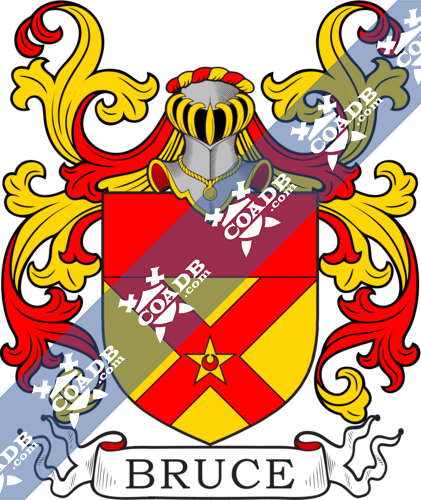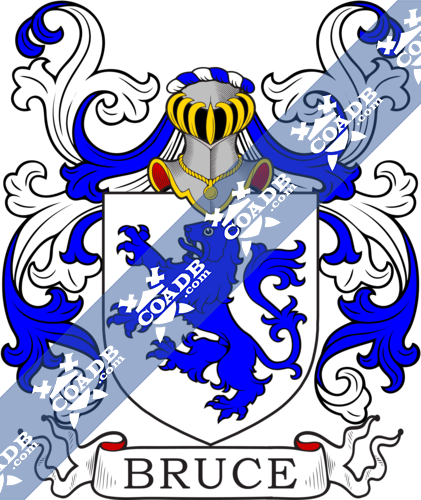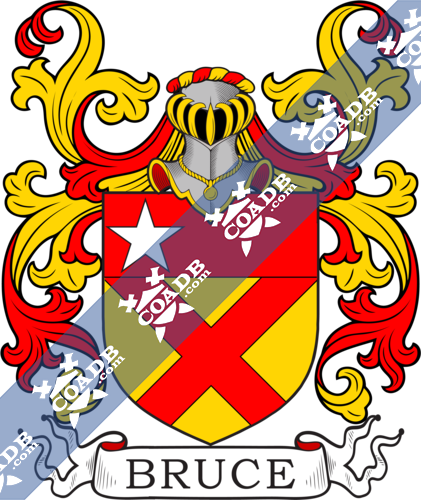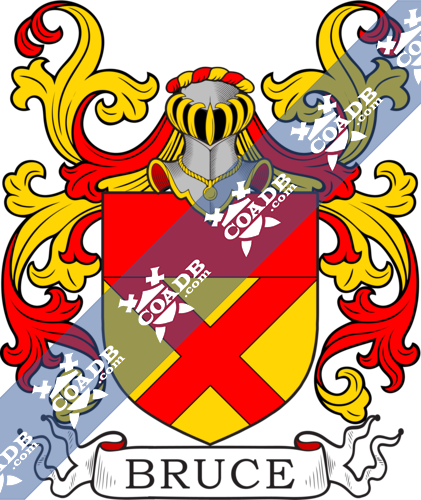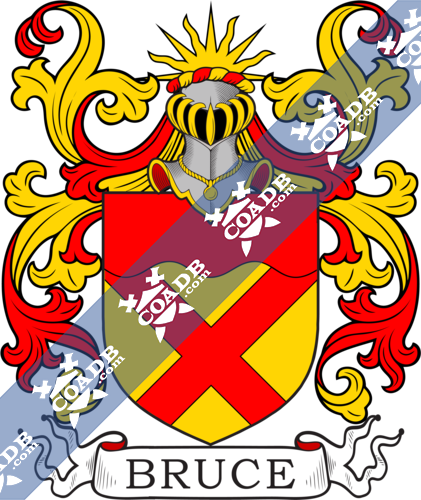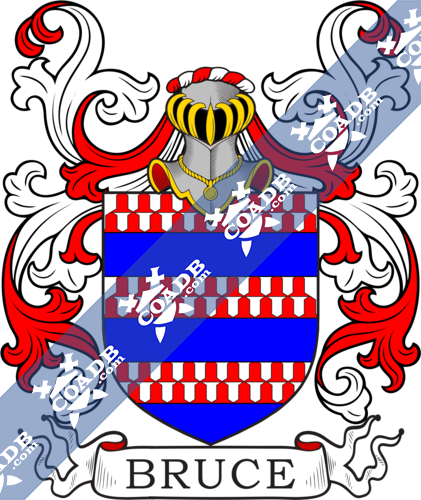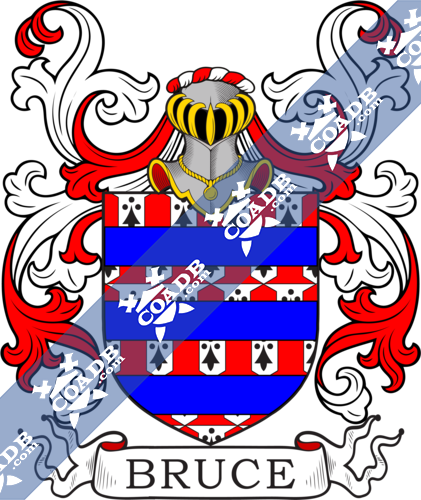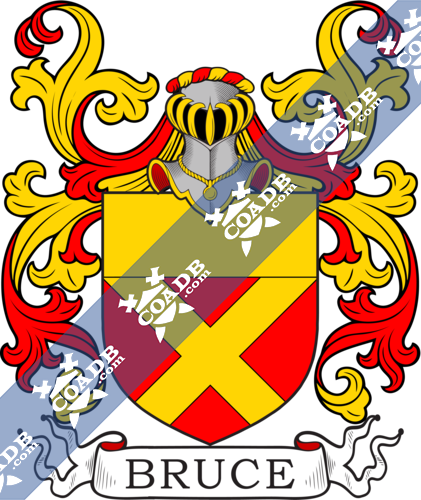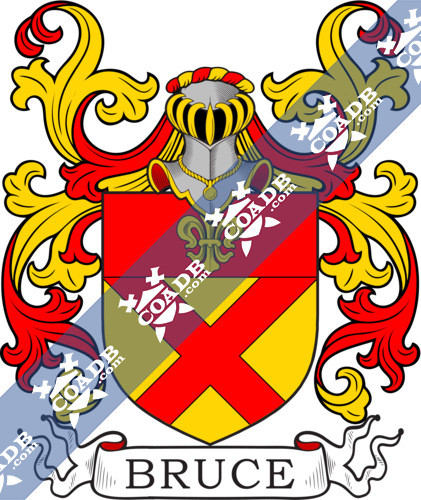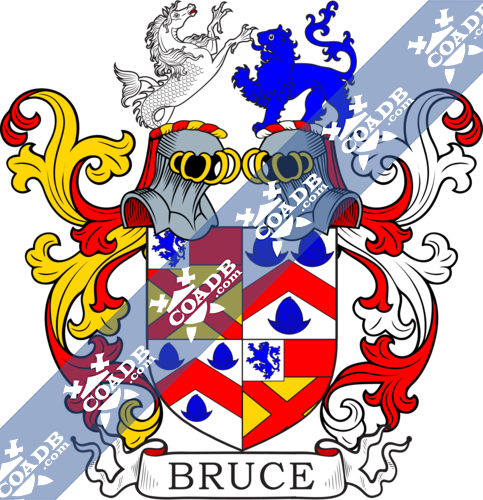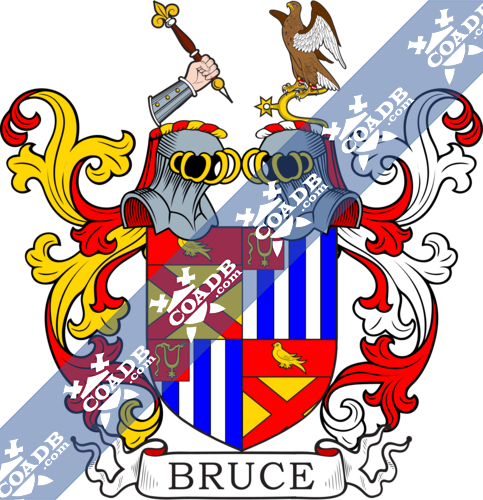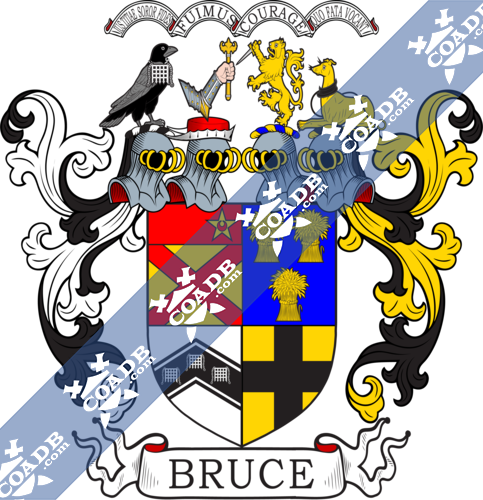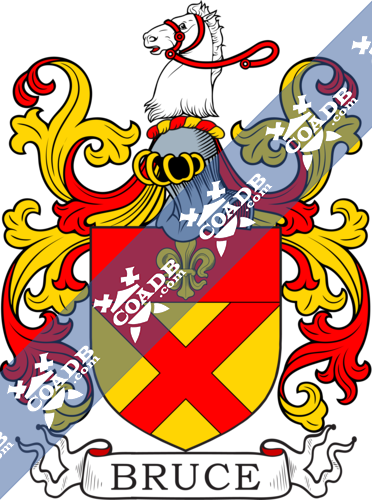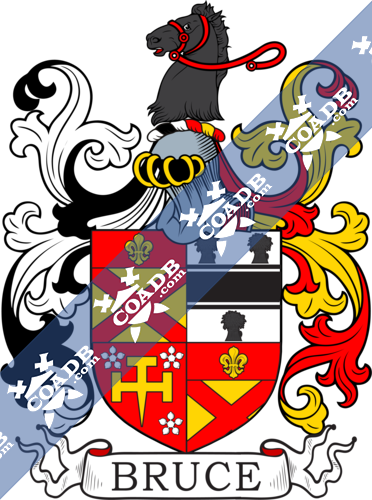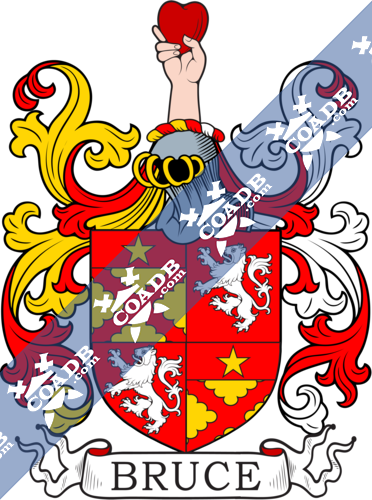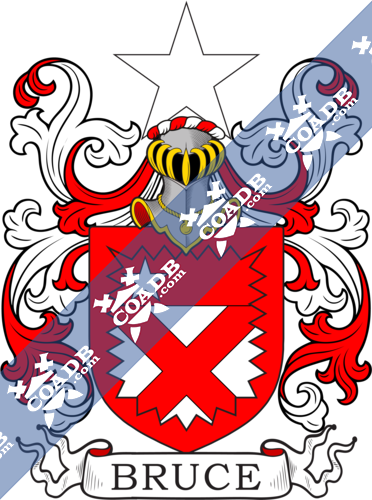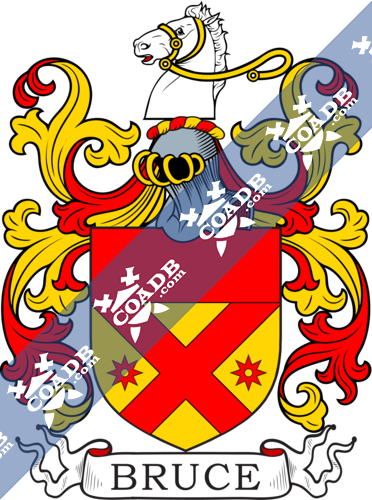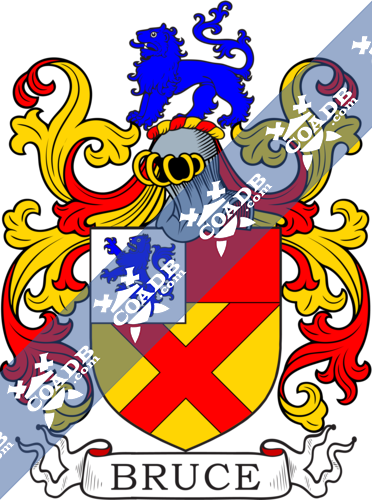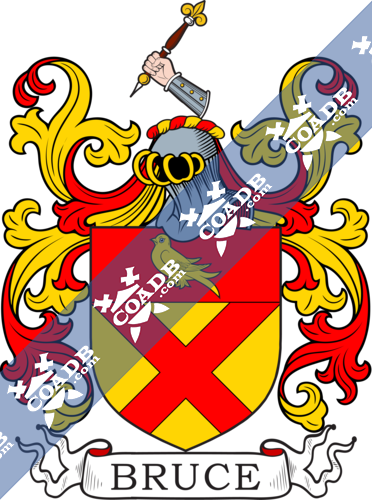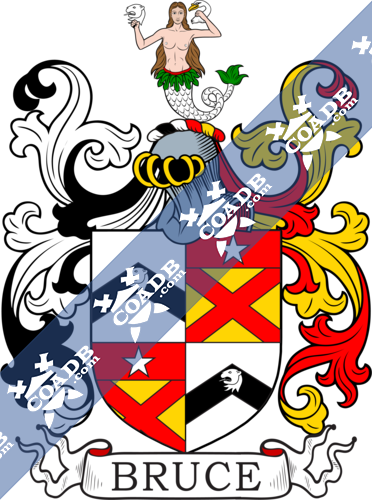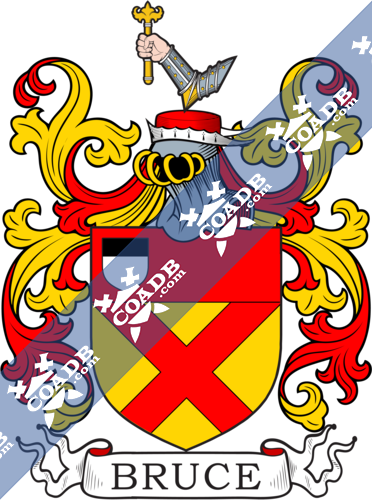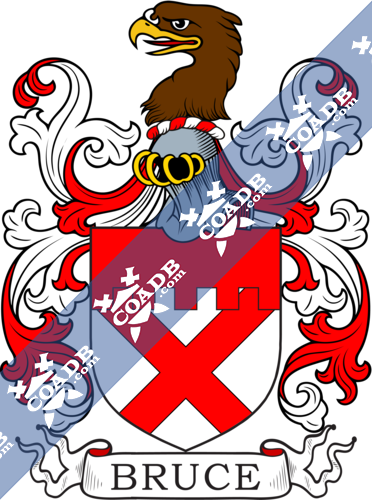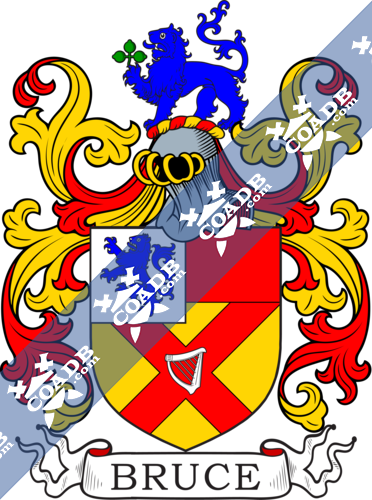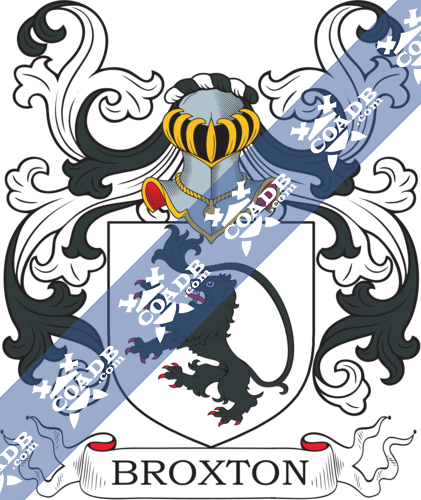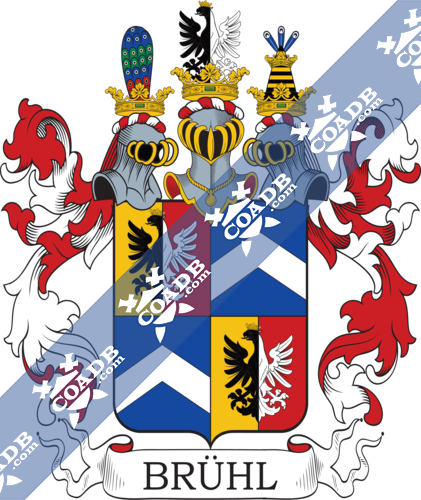Bruce Family Crest, Coat of Arms and Name History

Bruce Coat of Arms Gallery
Don’t know which Coat of Arms is yours?
We can do a genealogical research. Find out the exact history of your family!
Learn MoreBruce Origin:
England, Scotland
Origins of Name:
The surname of Bruce is of Scottish and Norman-French origins. This surname is a locational name from an extensive fortress between the cities of Vherbourg and Vherbourg. The fortress was built by Adam de Brus at Brix, from Normandy, which was called the “Chateau d’Adam.” Because this surname of Bruce is locational, this means that the surname was often taken by the Lord or owner of the land from which the name derives. Others who may have taken a locational surname are people who have migrated out of the area to seek out work. The easiest way to identify someone who was a stranger at that time was by the name of their birthplace. The other possible places that this surname of Bruce is locational for are in Brieuxe, which was a place in Normandy. This surname of Bruce was introduced to the country of England following the Norman Conquest of 1066.
Variations:
More common variations are: Brewis, Browse, Bruice, Brucee, Bruece, Pbruce, Bruuce, Bruyce, Brouce, Brucea, Brruce, Breuce
History:
England:
The first recorded spelling of the surname of Bruce was in the country of England in the year of 1086. One person, who was recorded to be named as Robert de Bruis was mentioned in the Doomsday Book of 1086. The Doomsday Book was a “Great Survey” of England, under the direction of King William I, who was also known as “The Conqueror,” and who ruled between the year 1066 and the year 1087. Other mentions of the surname of Bruce in the country of England include one Robert de Brus, who was mentioned in Clerkenwell, Middlesex in the year of 1152, and Richard de Brus, who was in Essex in the year of 1274. Those who bear the surname of Bruce in the country of England can be found throughout the country, but mostly in the northeast region. The areas with the highest concentration of those who carry this surname are found in the counties of Northumberland, Durham, Yorkshire and Lancashire, as well as Essex county and the city of London.
Scotland:
Those who bear the surname of Bruce who inhabit the country of Scotland can be found all over the nation. The greatest concentration of those who are known by the surname of Bruce can be found in the counties of Aberdeenshire, Angus, Banffshire, Fife, Midlothian and Lanarkshire.
United States of America:
During the European Migration, settlers across Europe decided to leave their homes, and sought after a better life. This new life was largely available in the United States of America, which at that time was referred to as The New World, or The Colonies, and promised freedom from religious persecution, new fulfilling and largely available work, and land. Settlers who carry the surname of Bruce did not migrate to the United States until almost 20 years into the European Migration. It is possible that someone who bore this surname attempted the journey, but could not survive the harsh conditions of travel. The first person to have the surname of Bruce to arrive in the United States was one Richard Bruce, who settled in the state of Virginia in the year 1638. Those who carry this surname of Bruce can be found in New York, Massachusetts, Illinois, Texas, California, Georgia, Pennsylvania, Indiana, Michigan, Ohio, Virginia, Kentucky, Tennessee, Missouri, Mississippi and Washington.
Here is the population distribution of the last name Bruce:
United States 61,837, Ghana 16,135, England 16,036, Canada 9,326, Nigeria 8,406, Australia 7,505, Scotland 6,976, South Africa 5,790, Togo 5,027, Uganda 3,361
Notable People:
John Bruce (1832-1901) who was a U.S. District Judge for Alabama from the year 1875 to the year 1901, and was a politician from America
Lieutenant-General Andrew Davis Bruce (1894-1969) who was the American Commandment of the Armed Forces Staff College from the year 1951 to the year 1954
David Kirkpatrick Este Bruce (1898-1977) who was a diplomat from America who served as the Ambassador to France, to the Republic of Germany and the United Kingdom, recipient of the Presidential Medal of Freedom
Thaddeus C. Bruce, who was the Member of Connecticut State Senate in the 21st District in the year 1842, and was a politician from America
William Bruce, who was an Alternate Delegate to the Republican National Convention from Maine in the year 1960, and was a Republican politician from America
William CaBell Bruce (1860-1946) who was a Member of the Maryland State Senate from the year 1894 to the year 1896, and was a U.S. Senator from Maryland in the year 1923 to the year 1929, and was a Democratic politician from America
Blazons & Genealogy Notes
1) (Brudenell-Bruce, Marquess of Aylesbury). Motto—Fuimus. Quarterly, 1st and 4th, or, a saltire and chief gu. on a canton ar. a lion ramp. az.; 2nd and 3rd, ar. a chev. gu. betw. three morions (steel caps) az. Crests—1st: A seahorse ar.; 2nd: A lion pass. az. Supporters—Two savages ppr. wreathed round the loins and temples vert, each supporting in the exterior hand a flag, thereon the first quarter of the arms.
2) (Earl of Elgin and Kincardine). Motto—Fuimus. Or, a saltire and chief gu. on a canton ar. a lion ramp. az. Crest—A lion statant az. Supporters—Two savages ppr. wreathed about the head and middle with laurel vert.
3) (Lord Aberdare). Mottoes— Above the crest, Fuimus; under the arms, Ofner na ofne angau. Or, a saltire and chief gu. the last charged with a martlet of the field. Crest—A cubit arm in armour in bend grasping a sceptre ppr. Supporters—Two lions collared, pendant from the collar of the dexter an escutcheon of the arms of Knight, and from the collar of the sinister an escutcheon of the arms of Bruce.
4) (Hovell-Thurlow-Cumming-Bruce; Baron Thurlow). Quarterly, 1st, Bruce: Or, a saltire gu. on a chief of the last In sinister canton a mullet of the first, charged with a crescent of the second; 2nd, Cumming: Az. three garbs or; 3rd, Thurlow: ar. on a chev. cottised sa. three portcullises with chains and rings of the first; 4th, Hovell: Or, a cross sa. Crests—1st, Bruce: On a cap of maintenance ppr. a dexter arm in armour from the shoulder, resting on the elbow, also ppr., the hand holding a sceptre erect or, Motto over, Fuimus; 2nd, Cumming: A lion ramp. or, holding in the dexter forepaw a dagger ppr., Motto over, Courage; 3rd, Thurlow: A raven ppr. gorged with a chain and pendent a portcullis ar., Motto over, Justitae soror fides; 4th, Hovell : A greyhound conchant or, collared and line reflexed over the back sa., Motto over, Quo fata vocant. Supporters—On either ride a greyhound or, collared and lined reflexed over the back sa.
5) (Kennet, now Lord Balfour of Burleigh). Motto—Omni solum forti patria. Quarterly, 1st and 4th, ar. on a chev. sa. an otter’s head erased of the first; 2nd and 3rd, or, a seiltire in chief gu. the latter charged with a mullet ar. Crest—A mermaid holding in her light hand an otter’s head, and in her left hand a swan’s head, all ppr. Supporters—Dexter an otter ppr.; sinister, a swan or.
6) (Airth and Stenhouse, co. Stirling, bart., 1629). Mottoes— Fuimus; and Do well and doubt not. Or, a saltire and chief gu., in the dexter chief point a shield ar. and chief sa. Crest—On a cap of maintenance a dexter arm armed from the shoulder resting on the elbow, and holding in the hand a sceptre, all ppr. Supporters (granted 1801)— Dexter, a chevalier in complete armour, having plumes of feathers on his helmet, and bearing in his right hand a sceptre as the Crest, all ppr., sinister a lion az. on his head the crown of King Robert II., gorged with that of King David, and chained with an antique chain or.
7) (Newton and Cowden, a cadet of Airth, represented by Hon. W. H. Bruce Ogilvy, as heir of line). Ar. a saltire gu. and chief embattled of the last. Crest—An eagle’s head ppr. Motto—Spes mea superne.
8) (Downhill, co. Derry, Ireland, bart., 1804, a cadet of Newton). Motto—Fuimus. (Newtownards, co. Down, granted 1804). Or, on a saltire gu. a harp ar. a chief of the second on a canton ar. a lion ramp. az. Crest—A lion pass. az. holding in his dexter paw a trefoil slipped vert.
9) (Earlshall). Or, a saltire and chief gu. the latter charged with a fleur-de-lis or.
10) (Wester Abden, co. Fife). Or, a saltire gu. on a chief of the last three fleurs-de-lis of the first.
11) (Grangehill, co. Fife, as represented of Earlshall, 1816). Mottoes—Be true: Fuimus. Or, a saltire and chief gu. the latter charged with a fleur-de-lis of the field. Crest—A horse’s head erased ar. bridled gu. Supporters—Two savages ppr., wreathed head and middle with laurel vert.
12) (Col. Walter Hamilton Tyndall Bbuce, of Grangehill and Falkland, 1873). Quarterly, 1st and 4th, or, a saltire and chief gu. the latter charged with a fleur-de-lis of the field; 2nd, ar. a fesse cottised sa. betw. three garbs of the last, for Tyndall; 3rd, gu. a cross potent fitchee or, betw. three cinquefoils ar., for Hamilton. Crest—A horse’s head erased sa. bridled gu.
13) (Mowanes, Shetland). Motto—Omnia vincit amor. Quarterly, 1st and 4th, or, a saltire engr. gu. on a chief of the second a mullet of the first; 2nd and 3rd, gu. a lion ramp. ar. Crest—A dexter hand erect, holding a heart ppr.
14) (Kinloch). Motto—Ad summa virtus. Ar. a saltire and chief gu. in dexter chief a mullet of the field, a bordure indented of the second. Crest—A star or.
15) (Garvel). Motto—Venture forward. Or, a saltire gu. on a chief embattled of the second a mullet ar. Crest—A hand holding a sword ppr.
16) (Urie, Shetland). Or, on a saltire gu. a mullet of the first charged with a crescent of the second, a chief of the second.
17) (Pittarthie, descended from Stanstill, Caithness). Motto—True. Or, a saltire betw. two spur rowels in fesse gu. a chief of the second. Crest—A horse’s head couped and furnished ppr.
18) (Skelton, Yorkshire). Ar. a lion ramp. az.
19) (Clackmanan, Scotland. Direct male line ended 1772; present heir of line, Hon. W. H. Bruce Ogilvy). In the 16th century. Or, a saltire and chief gu. the latter charged with a mullet ar. in dexter chief.
20) (Clackmanan, Scotland. Direct male line ended 1772; present heir of line, Hon. W. H. Bruce Ogilvy). After the 16th century. Or, a saltire and chief gu.
21) (Balcaskie and Kinross, bart., 1668, descended from Blairhall, a cadet of Clackmanan). Or, a saltire gu. and chief wavy of the last. Crest—The sun going down ppr. Supporters —Two cranes reguard. ppr.
22) (the Right Hon. Sir James Lewis Knight-Bruce, of Roehampton Priory, Surrey, first Vice-Chancellor of England, and afterwards Lord Justice of Appeal). Motto—Fuimus. Quarterly, 1st and 4th, or, a saltire gu. on a chief of the second a martlet of the field, for Bruce; 2nd and 3rd, paly of six ar. and az. on a canton of the second a spur with rowel downwards, leathered or., for Knight. Crests—1st: A cubit arm in armour in bend grasping a sceptre all ppr., for Bruce; 2nd: On a spur lying fesseways or, a hawk, wings elevated ppr., for Knight.
23) (formerly Brice, granted in 1831, to Edward Bruce, Esq. of Kilroot, co. Antrim, descended from Robert Brice, otherwise Bruce of Castle Chichester, in that co., on his changing his name from Brice to Bruce). Motto—Do well, doubt nought. Or, a saltireband chief gu. a mullet in the dexter canton of the first. Crest—A cubit arm holding a scimitar ppr.
24) Barry of six vaire ar. gu. and az.
25) Vaire erm. and gu. three bars az.
26) Gu. a saltire and chief or.

